EQUINE WELFARE NETWORK PROFILE
The Place of Horses
AKA/DBA The Whole Horse Place
https://www.thewholehorseplace.com
The Place of Horses
4764 SW OLD FOREST WAY
PORT ORCHARD, WA 98367
Founded: 2021
Profile Last Updated October 30, 2025
4764 SW OLD FOREST WAY
PORT ORCHARD, WA 98367
Mailing Address:
4764 SW OLD FOREST WAY
PORT ORCHARD, WA 98367
Phone: 360-895-0940
MAKE AN INQUIRY
View our WEBSITE
EIN: 87-3829076Founded: 2021
Profile Last Updated October 30, 2025
Public Charity
MISSION & PROGRAMS
Mission:The Whole Horse Place's mission is to make a positive difference in the lives of old horses and humans of all ages by fostering bonds through comprehensive horse care and education. We rescue senior horses and give them new purpose in teaching humans responsibility, confidence, self respect, resiliency, and emotional honesty.
Our organization provides programs involved with equine rescue & retirement
Our organization provides outreach and/or public education programs involving horses.
100% of our total programs and services are equine-related.
Our organization is directly responsible for the care and shelter of equines involved in our programs.
Our organization does not CURRENTLY use satellite, overflow, foster, and/or outreach facilities.
Please describe what steps your organization takes to ensure that:
1) all interactions between your equines and people are mutually beneficial and conducted in accordance with the Guidelines for Human-Equine Interactions stated below;
2) all equines in the care of our organization and/or equines that participate in the organization's program have access to clean drinking water at all times; nutritious food in sufficient quantity, including natural forage such as pasture grass and/or hay; appropriate veterinary, farrier, and dental care; shelter and protection from the weather; sufficient safe space to move around comfortably on a daily basis; and daily opportunity to freely interact and have contact with other equines:
At The Whole Horse Place, all human-equine interactions are guided by respect, responsibility, and mutual benefit, in alignment with the EQUUS Foundation Guidelines for Human-Equine Interactions. Our programs emphasize that participants are there to care for the horses—not the other way around. Youth and veterans learn to read equine body language, respond with empathy, and build trust through consistent, respectful handling. Riding is never the goal; trust and connection are.
Our horses have continuous access to clean drinking water and are fed multiple times daily with high-quality hay, senior feed, or pellet hay and senior feed mashes, and appropriate supplements. Each horse also has slow feeders of bluegrass straw for 24/7 access to something to chew on. Each horse receives routine veterinary, dental, chiropractic, massage therapy, and farrier care, along with individualized support for age-related conditions such as arthritis or ulcers.
Horses are housed in 12x12 or 10x15 stalls with 24/7 access to attached dry paddocks, allowing them to move freely and engage in natural behaviors year-round. Each stall is equipped with a fan during hot weather for comfort and heat relief. Horses also participate in trail walks and hand-grazing in open meadows. All equines have regular social interaction with other horses and are never kept in isolation unless medically required, and even then, they have access to see the other horses.
Even non-rideable horses are active participants in the program through groundwork, grooming, and companionship. We are committed to providing a safe, enriching, and compassionate environment that prioritizes the lifelong well-being and dignity of every horse in our care.
Equine Transition Services:
Overview of our programs involved with rescue, rehabilitation, retraining, re-homing and/or retirement:
The Whole Horse Place provides a safe haven for senior and at-risk horses that would otherwise face euthanasia. We specialize in rescue, rehabilitation, retraining tune-ups, and long-term retirement, integrating each horse into our hands-on youth and veteran programs whenever possible.
When a rescued horse needs more space or specialized care than our 2.5-acre site can provide, we board them at a trusted partner facility with 25 acres of divided pasture for rehab or retirement. We also send horses to professional trainers for “tune-ups” to ensure they’re physically and emotionally ready to safely interact with program participants.
At our main barn, each horse enjoys 12×12 or 10×15 stalls equipped with fans in summer and 24/7 access to attached dry paddocks. We supplement forage with hand-grazing and trail rides on leased Alpine Evergreen Trails meadows. Every horse receives routine veterinary, dental, and farrier care, plus individualized support for age-related conditions.
Our focus is on giving each horse the best possible quality of life—whether through daily program work, off-site rehabilitation, or a peaceful retirement—always guided by their unique needs.
Outreach and/or Public Education:
The Whole Horse Place offers year-round public education and outreach focused on the care, value, and emotional impact of senior horses. While we do not offer credentialed Equine Assisted Services, our programs provide powerful, hands-on experiences that teach responsibility, emotional regulation, and the importance of empathy through direct interaction with horses.
Our Stable Paths program, offered free of charge, is facilitated by volunteer licensed drug and alcohol counselor, and has become a trusted community resource. The Kitsap County Sheriff’s Department and Kitsap Recovery Center now refer youth and families to the program, where participants engage in horse care, barn chores, guided discussions, and reflective activities. The horses act as mirrors, offering nonjudgmental feedback and helping participants practice emotional regulation and leadership.
In addition to Stable Paths, we offer family horse time, and barn visits where community members can learn about senior horse care—feeding, grooming, basic veterinary support, and groundwork. These experiences are available year-round and supported by dedicated volunteers who help create a safe, consistent, and welcoming environment for all.
Research/Medical Use of Equines:
Our organization has never made, and would not ever consider making, equines available for research studies or medical training that involves invasive procedures and/or that which may cause pain or suffering to the equine.
Religious Affiliation:
Our organization does not promote religious education, religious purposes, or a specific religious faith or use donations for religious education or religious purposes; require participants to be of a certain faith; require participation in religious, instruction, activities or services; or require participation in prayer, worship, religious instruction or other religious activities as a condition of receiving social or secular services offered.
Auction Donation:
Our organization has never allowed, or would not consider allowing, an equine to be sold, transferred, released, or otherwise placed into possession of any person or organization that would cause or allow the equine to be sold at auction for slaughter.
POLICIES: INTAKE, ASSESSMENT & TRAINING
Prior to a horse being accepted and/or arriving at the facility, the organization has the following policies in place:The owner of a potential equine is interviewed over the phone or in person prior to seeing the equine
The equine is evaluated at its place of residence
If health records are not available or are out-of-date, our veterinarian will administer appropriate vaccinations
Not Checked:
The owner completes an application/contract which constitutes the agreement between the owner and our organization when the equine is acquired from the equine's owner other than by seizure or by abandonment
The owner is financially responsible for the shipping of the equine to and from the organization
A health certificate signed by a veterinarian and dated no more than seven days prior to arrival is provided to our organization either prior to or upon arrival of the equine attesting to the health status of the equine
The owner completes an application/contract which constitutes the agreement between the owner and our organization when the equine is acquired from the equine's owner other than by seizure or by abandonment
The owner is financially responsible for the shipping of the equine to and from the organization
A health certificate signed by a veterinarian and dated no more than seven days prior to arrival is provided to our organization either prior to or upon arrival of the equine attesting to the health status of the equine
Trial Period: Check all that apply:
Equines are not taken on trial
Upon intake, the organization has the following quarantine policy in place:
The equine is confined to a designated and separate area for isolation and quarantine at the facility for a prescribed period of time
Not Checked:
The equine is confined to a designated and separate area for isolation and quarantine off-site for a prescribed period of time
The equine is not quarantined
The equine is confined to a designated and separate area for isolation and quarantine off-site for a prescribed period of time
The equine is not quarantined
The typical length of quarantine is: Up to 10 days
Following arrival of the equine at the facility, the following is performed:
Physical examination to include temperature, pulse and respiration by a veterinarian upon arrival
A Henneke Body Conditioning Score or other body conditioning score is assigned by a veterinarian upon arrival
Physical examination by a farrier
Physical examination by a dentist
Not Checked:
Physical examination to include temperature, pulse and respiration by a trained staff member upon arrival
A Henneke Body Conditioning Score or other body conditioning score is assigned by a trained staff member upon arrival
Photographs are taken of each equine upon arrival at the facility and kept with the equine's health records
The equine is microchipped if the equine has not been microchipped
Physical examination to include temperature, pulse and respiration by a trained staff member upon arrival
A Henneke Body Conditioning Score or other body conditioning score is assigned by a trained staff member upon arrival
Photographs are taken of each equine upon arrival at the facility and kept with the equine's health records
The equine is microchipped if the equine has not been microchipped
Horses are assessed for following skills and behaviors:
Retrieval from a pasture/paddock
Leading with a halter and lead rope
Temperament, disposition and attitude, such as rated from very calm to very high spirited
Saddling
Lunging
Loading onto and unloading off a trailer
Mounting and dismounting
Riding at the walk
Riding by a beginner and/or unbalanced rider
Tolerance to unusual objects and loud noises
Known vices, i.e., cribbing, biting, kicking, weaving, stall walking, etc
Grooming
Bathing
Tolerance to multiple handlers at the same time
Not Checked:
Bridling
Riding at the trot
Riding at the canter
Jumping
Driving (Pulling a carriage)
Clipping
Bridling
Riding at the trot
Riding at the canter
Jumping
Driving (Pulling a carriage)
Clipping
Our organization has the following policies and procedures in place pertaining to the ongoing assessment of horses in its care:
Physical examination by a veterinarian at least annually
The Henneke Body Condition score or other body conditioning score is updated at least annually by the veterinarian
Vaccinations are administered at least annually
Equines at our facility may be treated by an equine chiropractor
Equines at our facility may be treated by an equine acupuncturist
Equines at our facility may be treated by an equine massage therapist
Equines at our facility may be treated by an equine nutritionist
Not Checked:
The Henneke Body Condition score or other body conditioning score is updated at least annually by a trained staff member
Photographs are taken of each equine monthly and kept with the equine's health records
Photographs are taken of each equine annually and kept with the equine's health records
The Henneke Body Condition score or other body conditioning score is updated at least annually by a trained staff member
Photographs are taken of each equine monthly and kept with the equine's health records
Photographs are taken of each equine annually and kept with the equine's health records
Our organization has the following policies and procedures in place pertaining to the weight-carrying or workload capabilities of horses/equines that are ridden in our care:
Our organization evaluates the weight-carrying and workload limitations for each equine that is ridden at least annually
Not Checked:
Our organization maintains a written record of the weight-carrying and workload limitations for each equine that is ridden
Our organization does not evaluate the weight-carrying and workload limitations for each equine that is ridden
No equines are ridden; not applicable
Our organization maintains a written record of the weight-carrying and workload limitations for each equine that is ridden
Our organization does not evaluate the weight-carrying and workload limitations for each equine that is ridden
No equines are ridden; not applicable
The following variables are considered in determining the weight-carrying and workload limitations for each equine that is ridden:
Equine age, weight, breed, body condition, fitness, balance, health and soundness
Equine conformation to include the top line, length of back, strength and width of loin, bone density (measured by the circumference of the cannon bone just below the knee)
Size, shape, condition and angle of the hooves
Participant weight, height, body proportions, balance, fitness and riding skills as well as behavioral issues and safety concerns
Weight and proper fit of the saddle and other equipment
Terrain and footing in the working environment
Duration and frequency of working sessions, as the frequency with which an equine is subjected to maximum weight carrying and/or workload
Nature and pace of work, repetitive or varied, radius of turns, degree of incline and regularity of footing when equine is subject to maximum weight-carrying capacity
Temperature and/or weather conditions
Seasonal impact on the equines' workload and weight-carrying capabilities and limitations
Not Checked:
Our organization does not evaluate the weight-carrying and workload limitations for each equine that is ridden
No equines are ridden; not applicable
Our organization does not evaluate the weight-carrying and workload limitations for each equine that is ridden
No equines are ridden; not applicable
Horses provided formal training (groundwork or riding): As needed; no set schedule
Additional information about our intake, assessment & training policies and practices:
All equines accepted into The Place of Horses are seniors, and intake decisions are made in partnership with our veterinarian. Horses must be evaluated to determine whether we can meet their medical, emotional, and physical needs. Most arrive with pre-existing conditions that require long-term care rather than retraining. We prioritize equines who are no longer rideable or have been overlooked due to age or chronic issues.
When intake is being considered, the current owner is interviewed, and a site visit may be made when feasible. Our vet performs a health check at intake or soon after arrival, especially if there are no valid health records. We do not require a seven-day health certificate because in many cases the horses are coming from private homes or informal settings, and it’s more appropriate for our vet to assess them directly. Horses are housed separately during intake, in quarantine paddocks near but not in contact with the herd.
Photos and body condition scores are taken at intake and updated periodically, but we are a small, volunteer-run organization and do not have formal re-evaluation checklists for every behavior or skill. Instead, we evaluate horses practically—whether they are safe around youth, tolerant of grooming and handling, and able to participate in ground-based interaction.
We do not ride most of our equines, and any riding that does occur is limited, closely supervised, and based on whether the horse is physically able and willing. The small number of horses who are cleared for riding are only ridden under specific circumstances: they must be assessed by our veterinarian as physically healthy enough to carry a rider, and the activity must be appropriate for their age, condition, and temperament. Riding is never expected or routine—it is considered only if the horse is comfortable, the activity is low-impact, and the rider is within recommended weight guidelines (generally not exceeding 15% of the horse’s body weight). Most riding is limited to light, occasional sessions, often for the purpose of evaluating the horse’s comfort, giving a gentle experience to a participant, or providing the horse with light exercise, and is always supervised by experienced adults. If at any time a horse shows signs of discomfort or reluctance, riding is discontinued immediately.
While we do not provide formal “training” to equines in the traditional sense, they do participate in daily handling, grooming, walking, ground driving, and other enrichment activities that involve youth and adult participants. We monitor their comfort levels closely, and if a horse appears sore, stressed, or disinterested, they are immediately given rest and adjusted expectations.
We do not turn horses away based on minor behavioral issues, but we do not accept horses who are unsafe, unpredictable, or in acute medical crisis unless we are specifically asked to intervene for end-of-life care, which is decided in consultation with our vet.
Our veterinarian is directly involved in all equine intake decisions. Each horse receives a veterinary check before being accepted into the program to ensure we can meet their medical and emotional needs. Intake decisions are based on whether the horse is a good fit for our environment and whether we can provide the appropriate level of long-term care.
As a small, volunteer-led organization, we do not currently maintain a formal written Equine Intake Guidelines document, but we are happy to describe our intake process in detail upon request. We also do not operate a foster or adoption program, so we do not have an active Adoption/Foster Agreement.
POLICIES: BREEDING
The organization has the following policies related to breeding and stallions:Our organization does not conduct breeding of equines owned or under the care of our organization.
Our main facility where our organization conducts its programs does NOT breed equines.
Not Checked:
One or more of the facilities where our organization conducts its programs, including foster/temporary care facilities, breeds equines
One or more of the facilities where our organization conducts its programs, including foster/temporary care facilities, are permitted to house stallions
One or more of the facilities where our organization conducts its programs, including foster/temporary care facilities, breeds equines
One or more of the facilities where our organization conducts its programs, including foster/temporary care facilities, are permitted to house stallions
Additional information about our breeding policies and practices:
We do not breed horses.
POLICIES: EUTHANASIA
The organization has the following policies related to euthanasia:Our organization will never have an equine euthanized for space
Our organization will have an equine euthanized upon the recommendation of the veterinarian if the equine is a threat to itself, other equines, or people
Our organization will have an equine euthanized upon the recommendation of the veterinarian after all reasonable treatment options have been explored
Euthanasia is done on site when possible to decrease trauma from transport
Disposal of the carcass is handled within 24 hours
Not Checked:
Our organization will never have an equine euthanized under any circumstances
Euthanasia is done at the veterinarian's facility
Our organization will never have an equine euthanized under any circumstances
Euthanasia is done at the veterinarian's facility
The following are authorized to administer the procedure for your organization in accordance with state laws:
Veterinarian
Not Checked:
A certified euthanasia technician
Senior staff with appropriate training
Employee of animal control shelter or humane society with appropriate training
Veterinary student under the supervision of a licensed veterinarian
Not applicable. Our organization prohibits euthanasia under any circumstances
A certified euthanasia technician
Senior staff with appropriate training
Employee of animal control shelter or humane society with appropriate training
Veterinary student under the supervision of a licensed veterinarian
Not applicable. Our organization prohibits euthanasia under any circumstances
Additional information about our euthanasia policies and practices:
Our vets uses Euthasol. it's an euthanasia solution specifally made for putting animals to sleep. (Pentobarbital Sodium and Phenytoin Sodium) Euthanasia Solution.
POLICIES: RE-HOMING
Re-homing Agreement not applicable.Our organization has the following re-homing (adoption/purchase) policies and procedures in place:
The organization does not re-home equines under any circumstances; our organization retains custody of our equines and ensures care of the equines for their lifetimes.
Our organization has the following policies and procedures related to horses that need to be retired, are no longer able to contribute to the mission of the organization, and/or are no longer manageable:
The organization does not re-home equines under any circumstances; our organization retains custody of our equines and ensures care of the equines for their lifetimes.
Equines may remain at our organization for their lifetimes
In the case an equine is unmanageable and demonstrates repeated dangerous behaviors, the equine may be euthanized upon the recommendation of the veterinarian
In the case an equine is unsound and/or unhealthy and cannot be treated to relieve suffering, the equine may be euthanized upon the recommendation of the veterinarian
The organization will accept financial responsibility for equines in the current care of the organization that need to be retired or are no longer able to contribute to the mission of the organization if all alternatives have been explored to find the equine an appropriate placement and space is not available for the equine to remain at the organization.
Not Checked:
Equines may be found suitable homes by our organization
Equines may be returned to their owners
Equines may be sent to auction
If a suitable home cannot be located within 12 months, the equine may be euthanized
Equines may be found suitable homes by our organization
Equines may be returned to their owners
Equines may be sent to auction
If a suitable home cannot be located within 12 months, the equine may be euthanized
Additional information about our rehoming policies and practices:
We do not rehome equines from our program. Our commitment is to provide lifetime care. In the rare instance that a horse cannot remain on-site — usually due to mobility needs that require more space than our paddocks allow — we continue to cover their board and veterinary care at a trusted off-site location managed by our long-time supporter, Dana Pederson.
We’ve found that rehoming a senior horse, especially one with ongoing health needs, rarely works out in the long run. These horses often help build a child’s confidence, but once the child outgrows them or wants a horse that can do more, the senior horse gets passed on. And each new home tends to be a little less ideal than the one before. Their maintenance is expensive, and too often, their care declines over time.
We don’t want that for any of our horses. Our goal is to be like Joe in Black Beauty — the kind person at the end of the story who finally gives the horse a forever home.
In one unique case, Chico — a horse with a painful shoulder and navicular condition — remains at our facility under shared ownership with a veteran and long-time volunteer, Josh. When Chico’s care costs exceeded what we could sustainably cover, Josh stepped in to share both financial and hands-on responsibility. If there ever comes a time when Josh is in a position to provide Chico with a secure retirement home elsewhere, we would thoughtfully consider it. But until then, Chico is safe, supported, and very much a part of our program.
Because we retain ownership (or shared ownership in rare cases) and are committed to providing lifelong care, we do not maintain a rehoming agreement and have not uploaded one.
EQUINE CARE & SHELTER/FACILITY INFORMATION
Our organization does not CURRENTLY use satellite, overflow, foster, and/or outreach facilities.Total facilities at which our organization cares for and shelters horses used in our programs: 1
The Whole Horse Place
4764 SW OLD FOREST WAY PORT ORCHARD WA 98367
Currently operational
Total number of horses/equines currently involved with your programs, under your care, and/or owned by your organization at this facility: 10
Total number of horses at this facility NOT INCLUDING those counted above: 1
Maximum capacity of horses at this facility: 12
Does your organization own, lease or use a part of this facility? Lease
Provide the contact information for the individual or organization responsible for investigating abuse in the county where the facility is located, including mailing address, email address, and phone information.
Kitsap Humane Society 9167 Dickey Road NW Silverdale, WA 98383 Phone:(360) 692-6977
Does your organization conduct Equine Assisted Services (EAS) at this facility in accordance with the EQUUS Foundation Guidelines on Qualifications of Organizations Conducting Equine Assisted Services (EAS)? No
ADDITIONAL INFORMATION ABOUT THIS FACILITY:
One horse is care leased by The Whole Horse Place but not owned by our organization. The owner keeps him here for the cost of his feed. It's a win win for both of us.
Our horses have 24/7 access to attached paddocks and are free to turn themselves out at will. They are not locked in stalls, except for medical reasons. Because turnout and stall areas are connected, our horses choose when to rest under cover and when to move around outdoors, depending on their needs, weather, and social comfort.
We enforce our no smoking policy by informing everyone as they arrive that smoking is not allowed anywhere on the property. Most of our participants are youth, so this is rarely an issue. If an adult does need to smoke, they are told to do so only in their car, away from all activity areas. We do not currently use signs; direct communication and supervision are effective for our small program.
Grounds: The Whole Horse Place (*Main) Currently operational This section is required.
Total acreage dedicated specifically to the horses: 2
Our organization has use of the following at this facility:
Structures/Barns: 0 Run-in sheds: 0
Pastures: 0 Paddocks/Pens/Turnout Areas: 0
Uncovered Outdoor Rings: 0 Covered Outdoor Rings: 0 Indoor Rings: 0
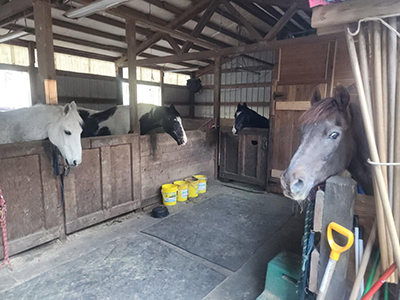
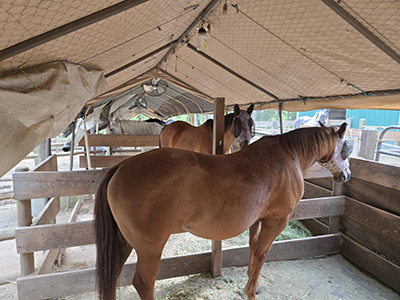
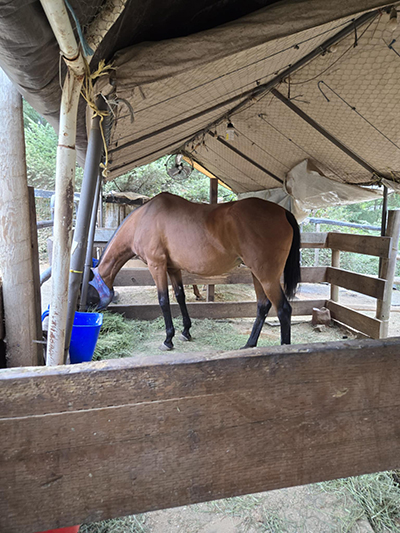
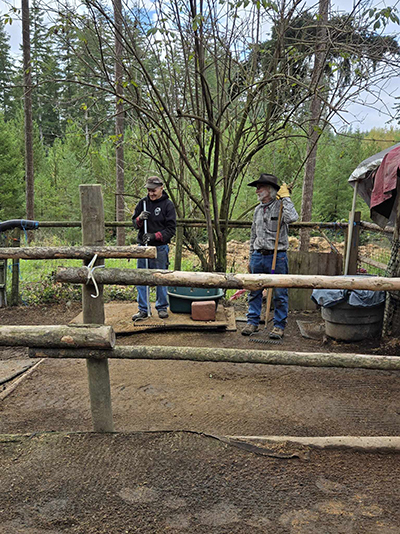
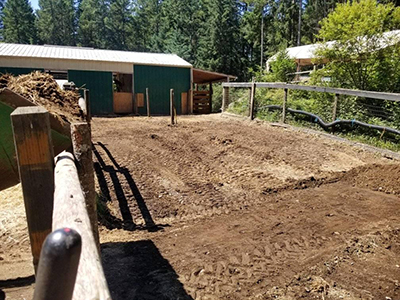
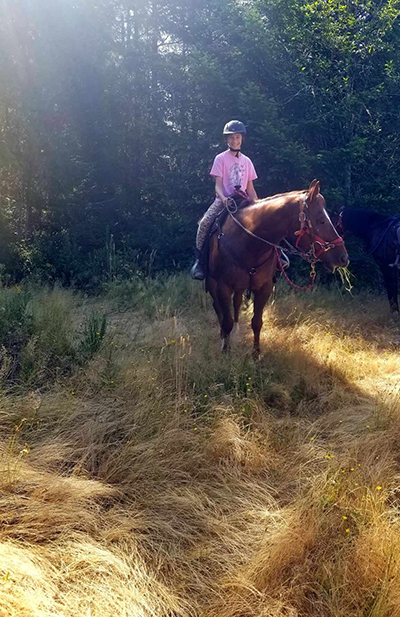
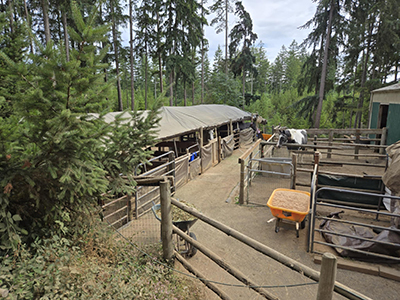
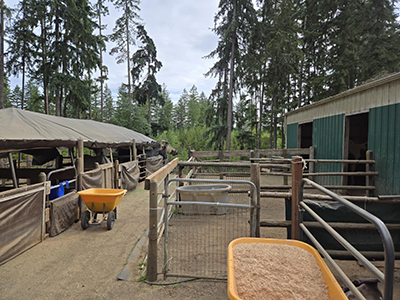
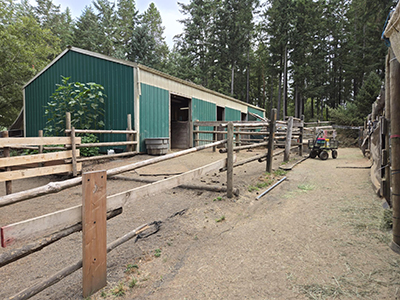
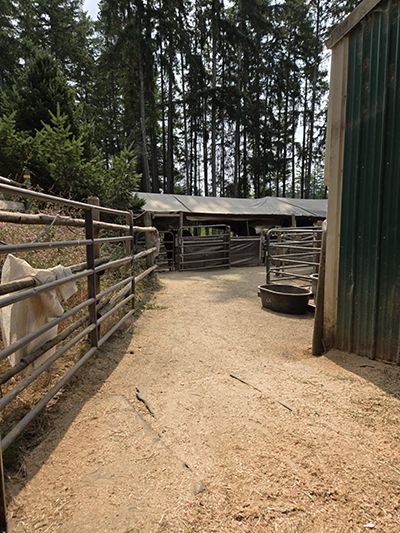
Are the organization's rules, restrictions and warnings (signage) conspicuously posted in easily accessible locations? Yes
Are the organization's emergency contacts, including veterinarian contact information, conspicuously posted in easily accessible locations? Yes
Are human and equine first aid kits easily accessible? Yes
Regarding all shelters where horses are housed including run-in sheds:
Do horses have assigned stalls in the barn/structure(s) or exclusively assigned shelter locations where they are separated from other horses with a barrier? Yes
How many hours per day, on average, are horses stalled or restricted to these sheltered exclusive shelter locations? 0-3;
How often are the stalls/shelters cleaned, i.e., kept in good repair and free of standing water, accumulated waste, sharp objects and debris? 6-7 Days a Week
Do all stalls/shelters allow horses to lie down, stand up and turn around and provide protection from inclement weather (wind, sleet, rain, snow and extreme temperatures)? Yes
Are stalls/shelters kept in good repair, with adequate ceiling height, and free of standing water, accumulated waste, sharp objects and debris? Yes
Are floors constructed and maintained for both good drainage and traction? Yes
Is there a ventilation and circulation system in place to allow free flow of air to control temperature, and humidity, and to prevent air stagnation? Yes
Is wiring inaccessible to horses and maintained for safety in all areas of facility? Yes
Are fire prevention/protection measures (fire alarms, extinguishers and sprinkler systems) maintained and in good working order? Yes
Is there adequate lighting to ensure safety in all areas of facility? Yes
How many hours per day, on average, are horses turned out:
Equines are out 24/7
Equines are out 24/7 except they are brought in to feed
Equines are out 24/7 except they are brought in if there is inclement weather
Equines are out 24/7 except when they are being trained
Equines are out 24/7 except when they are used for the conduct of the organization's programs
The following describes the pastures at this facility:
This facility does not have pastures where equines can graze on pasture grass
Not Checked:
This facility has a written plan in place for pasture management, which includes guidelines for seeding, fertilizing, irrigation, mowing, dragging, harrowing, manure removal, removal of debris, the control of poisonous plants, and a schedule for cleaning
A dedicated staff person(s) is responsible for pasture management
All pastures are fenced to prevent escape or injury
Barbed wire is used for fencing
Electric fencing is used; electric wires or tape fence are visibly marked
Fencing checks, such as broken or missing planks, loose fence posts, exposed or loose nails, detached wires, etc., are done regularly
Pastures are rotated
Pastures have natural protection for equines (i.e., trees)
Pastures have man-made protection for equines (i.e., shelters)
This facility has a written plan in place for pasture management, which includes guidelines for seeding, fertilizing, irrigation, mowing, dragging, harrowing, manure removal, removal of debris, the control of poisonous plants, and a schedule for cleaning
A dedicated staff person(s) is responsible for pasture management
All pastures are fenced to prevent escape or injury
Barbed wire is used for fencing
Electric fencing is used; electric wires or tape fence are visibly marked
Fencing checks, such as broken or missing planks, loose fence posts, exposed or loose nails, detached wires, etc., are done regularly
Pastures are rotated
Pastures have natural protection for equines (i.e., trees)
Pastures have man-made protection for equines (i.e., shelters)
The following describes the turnout areas other than pastures at this facility:
This facility has a written plan in place for the maintenance of turnout areas, which includes a schedule for cleaning, manure removal, and dragging
A dedicated staff person(s) is responsible for the maintenance of turnout areas
All turnout areas are fenced to prevent escape or injury
Turnout areas have man-made protection for equines (i.e., shelters)
Fencing checks, such as broken or missing planks, loose fence posts, exposed or loose nails, detached wires, etc., are done regularly
Not Checked:
This facility does not have turnout areas
Barbed wire is used for fencing
Electric fencing is used; electric wires or tape fence are visibly marked
This facility does not have turnout areas
Barbed wire is used for fencing
Electric fencing is used; electric wires or tape fence are visibly marked
The following policies and procedures are in place at the facility to restrict public access and to keep horses safe:
The property owner, staff member or caretaker lives on the premises and ensures that public access is restricted and is responsible for the security of the facility and equines
There is a practice in place to monitor equines overnight
Hold Harmless signs are posted
Entrance gates are locked at night
Visitors are only permitted at specific times
Visitors are only permitted in specific areas
The property is fitted with motion lights
Not Checked:
A security guard is present at night
By Appointment Only signs are posted.
No Trespassing signs are posted
Authorized Personnel Only signs are posted
The property is fitted with a security system monitored by police or a professional service
The property is fitted with a security system that is monitored internally by staff (or the property owner)
The perimeter of the property is fully fenced
A security guard is present at night
By Appointment Only signs are posted.
No Trespassing signs are posted
Authorized Personnel Only signs are posted
The property is fitted with a security system monitored by police or a professional service
The property is fitted with a security system that is monitored internally by staff (or the property owner)
The perimeter of the property is fully fenced
Equine Care/Emergency Preparedness: The Whole Horse Place (*Main) 2025 and 2024 This section is required.
Horse Health Care/Barn Management Records: What system is used to collect and store health/horse care records?
Notebook or equivalent (technology not utilized)
The following items are consistent with our feed management plan and practices:
Equines are provided with individualized feeding plans, including supplements, according to the equine's age, breed/type, condition, size, work level and any health issues, consisting of nutritious food provided in sufficient quantity and access to adequate natural forage, or be fed daily, or as recommended by the organization's veterinarian
Feed plans are determined in consultation with a veterinarian
Supplement plans are determined in consultation with a veterinarian
Equines are fed grain in individual stalls
Staff and/or volunteers are trained in proper feed measurements and protocols and observed periodically to ensure they are feeding correctly
The feed chart is centrally located and updated as needed
The area(s) where hay, feed, grain, and supplements are stored are kept clean, free of debris and chemicals, and protected from weather and other animals in rodent-proof and mold-proof containers and grain bins
Feed, supplements and hay types are clearly labeled
Water sources, i.e., buckets, troughs, automatic waterers, etc. are kept clean, free of contaminants, debris and chemicals, protected from weather and other animals, and be positioned or affixed to minimize spillage.
Medications are kept in a secure area
Not Checked:
Equines are fed grain in groups
Equines are fed grain in groups
Is clean, potable water available at all times for all equines, or if not at all times, at least twice daily? Yes
Hoof Care: How often is hoof care provided for each equine? Every 4-8 weeks and when an issue arises
Dental Care: How often is dental care provided for each equine? Annually and when an issue arises
Horse checks: How often are equines visually and physically checked by personnel at the facility? Every day or 6 days a week
Our organization has the following parasite and fly/insect control protocols in place, including remedies used to control flies and insects:
Fly/Insect Control Remedies:
Fly Traps and Tapes
Fly Spray Repellent
Fly Masks
Fly Sheets
Fans
Not Checked:
Our organization follows the parasite control guidelines of our veterinarian, including fecal testing and de-worming
Our organization follows the parasite control guidelines of our veterinarian, including fecal testing and de-worming
The following represent the biosecurity practices in place at facility:
Our organization follows the biosecurity guidelines of our veterinarian
Sick, affected and/or quarantined equines do not have contact with other equines or other animals
Staff are trained in best practices related to biosecurity
Volunteers are trained in best practices related to biosecurity
A specific individual is trained and assigned to care for sick, affected and/or quarantined equines
Sick, affected and/or quarantined equines are cared for last if the caretaker must also care for healthy equines
Restricted access signs are posted at primary points of access to sick, affected and/or quarantined equines
Hand sanitizers are available at all primary points of access to sick, affected and/or quarantined equines
Footbaths are available at all primary points of access to sick, affected and/or quarantined equines
Manure and bedding from sick, affected and/or quarantined equines is removed from the facility - not put in open air piles, and not spread on pastures
Quarantine areas, such as stalls, aisle ways, paddocks, and common areas, are cleaned (and needed, disinfected) after conclusion of the quarantine.
Trailers/vans used by sick, affected and/or quarantined equines are cleaned and disinfected after each use and cleaning takes place away from where equines are sheltered
Equipment used by sick, affected and/or quarantined equines is not shared
Equipment used by sick, affected and/or quarantined equines is cleaned of organic debris and disinfected after each use
Latex gloves, or equivalent gloves, are worn when working with sick, affected and/or quarantined equines
Not Checked:
The organization has a written biosecurity plan
Equines are not quarantined on arrival.
The organization has a written biosecurity plan
Equines are not quarantined on arrival.
Additional information on biosecurity:
there isn't a place to update the no smoking policy, so I am putting it here in addition to the Facility Overview comments section: We enforce our no smoking policy by informing everyone as they arrive that smoking is not allowed anywhere on the property. Most of our participants are youth, so this is rarely an issue. If an adult does need to smoke, they are told to do so only in their car, away from all activity areas. We do not currently use signs; direct communication and supervision are effective for our small program.
The following represent the manure removal practices in place at facility:
Manure is piled in an area where equines are not located
Manure piles are covered
Manure is hauled, sold or given away
Manure piles are composted or spread on pastures
Our organization adheres to the manure management guidelines set by the state, local authorities, and/or our organization's veterinarian
Not Checked:
Manure is stored in dumpster(s)
Manure is stored in dumpster(s)
The following steps are taken to help staff and volunteers readily identify each horse on the property:
Equines are assigned the same exclusive stall/shelter location each day
Equine photos and profiles are available on the website
Staff/volunteers are provided training on conformation, markings, colors, and breeds
Team leaders work with new staff/volunteers until they are able to identify the equines
Not Checked:
Name plates are located on the stall/shelter location
Photos are located on the stall/shelter location
Equines wear halters with nametags
A notebook or binder with photos and information on each equine is easily accessible
A map/diagram is posted showing the location of each equine with equine names and photos
Staff and volunteers are provided with an information packet with equine profiles, including photos and detailed descriptions
Name plates are located on the stall/shelter location
Photos are located on the stall/shelter location
Equines wear halters with nametags
A notebook or binder with photos and information on each equine is easily accessible
A map/diagram is posted showing the location of each equine with equine names and photos
Staff and volunteers are provided with an information packet with equine profiles, including photos and detailed descriptions
Our organization has the following policies and procedures in place pertaining to tack, apparel and equipment:
All equines have specifically assigned tack, apparel and equipment that is not shared
Blankets, sheets and turn out apparel are fitted and utilized for each equine appropriate to the equine's needs and the weather conditions
Blankets, sheets and turn out apparel are cleaned regularly as needed
Tack is cleaned only when needed
Tack is assessed for fit before each use by trained personnel
Tack is assessed for fit by trained personnel when an equine's body condition changes
Tack is assessed for fit by trained personnel when an equine's disposition changes
This facility enlists the services of a professional saddle fitter at least once a year
Assigned tack is clearly labeled
Tack is stored in a climate-controlled location
Helmets are shared
Helmets are cleaned/disinfected after each use
Helmets are replaced after a fall
Helmets are replaced at least every five years.
Not Checked:
Saddles are shared
Saddle pads are shared
Bridles are shared
Bits are shared
Blankets are shared
Sheets are shared
Turnout apparel is shared
Halters are shared
Tack is cleaned after each use
Tack is cleaned weekly
Tack is inspected for overall working condition before each use by trained personnel
No equines are ridden; not applicable.
Saddles are shared
Saddle pads are shared
Bridles are shared
Bits are shared
Blankets are shared
Sheets are shared
Turnout apparel is shared
Halters are shared
Tack is cleaned after each use
Tack is cleaned weekly
Tack is inspected for overall working condition before each use by trained personnel
No equines are ridden; not applicable.
Emergency Preparedness: The Whole Horse Place: *Main This section is required.
The following plans, policies, and procedures are in place at the facility to handle emergencies and address weather related issues, fire safety procedures, and/or any additional hazardous scenarios the facility could potentially experience:
Emergency phone numbers are posted prominently
The facility maintains at least two weeks of hay, feed, shavings and medications
The facility collects and maintains medical information from staff, volunteers, and clients
The facility maintains appropriate liability and/or workers' compensation insurance
Not Checked:
Emergency procedures are posted prominently
The facility owns or has access to a generator
The organization has a written emergency preparedness/safety plan (EPP)
Emergency procedures are posted prominently
The facility owns or has access to a generator
The organization has a written emergency preparedness/safety plan (EPP)
The facility follows the specific procedures to help PREVENT emergency situations:
Smoking is strictly prohibited
Hay is stored away from permanent or temporary structures where equines are stalled
Permanent or temporary structures where equines are stalled are kept free of dust, cobwebs, trash, cleaning rags, and other flammable items
Aisles and doorways are kept clear
Not Checked:
NO SMOKING signs are posted prominently
Heaters with automatic shutoff settings are used
NO SMOKING signs are posted prominently
Heaters with automatic shutoff settings are used
How often are the following checked or performed?
Fire Extinguishers are checked: Annually
Smoke detectors are checked: Annually
Fence lines are checked: Daily
Turnout Areas are checked: Daily
Sprinkler systems are checked: Not at all/NA
Fire drills are conducted: Not at all/NA
Review of safety protocols with staff are conducted: Weekly
Review of safety protocols with volunteers are conducted: Weekly
The Emergency Preparedness Plan is reviewed and updated: Not at all/NA
Equine Transportation: 7= Onsite: 3 (1 + 2) + Offsite: 4
2-horse van/trailer with truck:
0 Owned onsite o Access onsite but not owned 1 Access offsite;
3-horse van/trailer with truck:
1 Owned onsite 2 Access onsite but not owned 3 Access offsite;
4-horse van/trailer with truck:
0 Owned onsite 0 Access onsite but not owned
6-horse van/trailer with truck:
0 Owned onsite 0 Access onsite but not owned
8-horse van/trailer with truck:
0 Owned onsite 0 Access onsite but not owned
10-horse van/trailer with truck:
0 Owned onsite 0 Access onsite but not owned